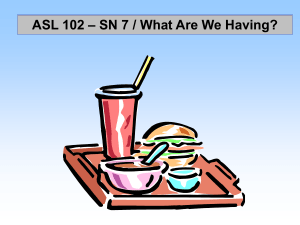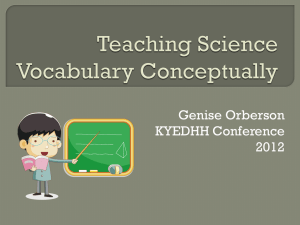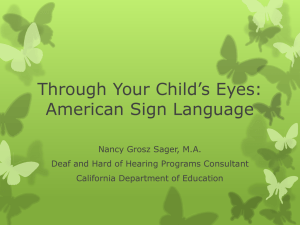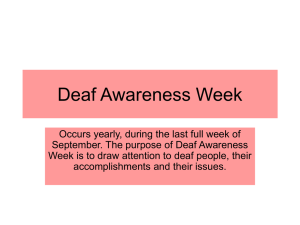Peter`s Picture PowerPoint - visual language and visual learning
advertisement
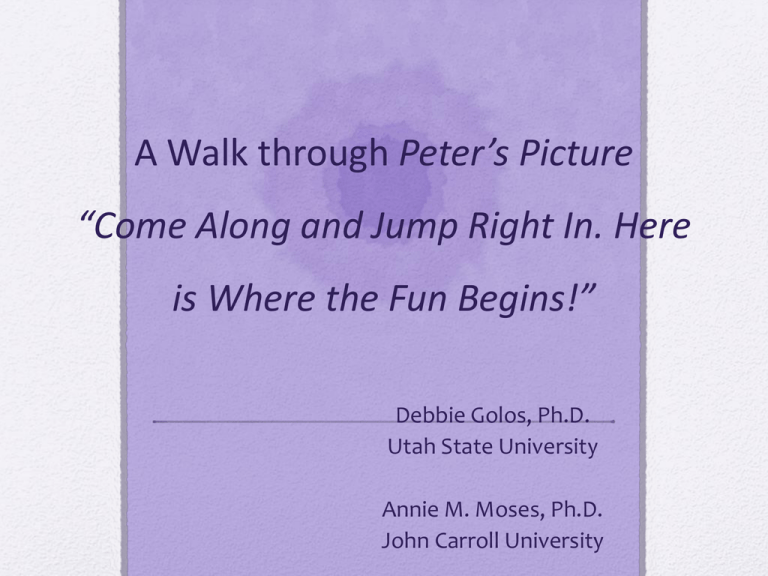
A Walk through Peter’s Picture “Come Along and Jump Right In. Here is Where the Fun Begins!” Debbie Golos, Ph.D. Utah State University Annie M. Moses, Ph.D. John Carroll University Today’s Purpose •Get to know the Peter’s Picture educational video series: •The curriculum •A tiny bit about the research •Suggestions for viewers •Directions for future research Why was Peter’s Picture Developed? • Deaf children need fluent visual language models from birth-This is critical! (e.g. ASL; Mayberry, 2010) • Visual language skills (e.g., ASL) have been positively linked with language and literacy skills (e.g. Chamberlain & Mayberry, 2008; Hoffmeister, 2000) • Many deaf children do not have fluent role models for ASL and Deaf culture. • While “face to face” is best. Educational media can provide support by additional opportunities to learn through visual language and visual strategies Research on Peter’s Picture • Recent studies have shown positive effects of the Peter’s Picture video series which incorporates research-based strategies to teach early ASL, vocabulary and English print. • As a result of watching the video(s), D/HH preschoolers: • Displayed a number of literacy-related behaviors while viewing, which increased with multiple viewings (Golos, 2010a) • A significant increase in target vocabulary in ASL and print English after viewing the same video three times (Golos, 2010b) • Greater increase in literacy behaviors with teacher mediation (Golos & Moses, 2011) • Significant increase pre-post test for sequencing, knowledge of story elements, vocabulary (Golos & Moses, 2013b) • Increase in skills with follow up teacher activities (Golos & Moses, in press) Summary • D/HH preschoolers’ knowledge of target words increased in a range of modes – by connecting fingerspelling and signing, to pictures and print • D/HH preschoolers ability to identify characters, setting, story events, and sequence them increased • Increase in targeted knowledge and skills in a multimedia format without sound and regardless of their baseline ASL skills or hearing loss What is Peter’s Picture? • Four themed-based, interactive, educational adventure video series • Each video has the same structure, but differ in the focal theme and vocabulary words • Each video is approximately 40 minutes in ASL (all no sound/one with sound) • Each video targets key early ASL and literacy skills, including vocabulary, letter recognition, concepts of print, comprehension, and grammatical features of ASL • Targeted to 3-6 year old children What Happens at Peter’s Place? • Peter teaches children target vocabulary (what they will do/see on their adventure) • Peter takes children on adventure to meet his friend (Letter of the Day= L; “Lucy the Librarian”) • At the location, Peter takes pictures of events • They come home, sequence the pictures, make a book, play a word game and finally Peter read’s aloud their books Designed for Visual Learners • Deaf friendly and literacy rich environment • Models fluent ASL • Models Deaf cultural rules • Deaf children interacting with other Deaf children and adults • Visual effects (flashing lights, sparkles etc.) Based on Theory • Emergent literacy: language and literacy develop from a child’s earliest years (e.g., Sulzby & Teale, 1991; Whitehurst & Lonigan, 2001) • For D/HH children, greater quantity and higher quality early experiences are imperative • Multiliteracies: include varying and multiple literacy-related and linguistic competencies (New London Group, 1996) • Builds upon linguistic (e.g., ASL) and cultural (Deaf) backgrounds • Present information using effective visual language and strategies Incorporates Research Based Practices (Golos & Moses, 2013a) • Interactive: asks questions of the audience/pause/ wait for a response/confirm • Models a literacy rich environment • Makes connections between ASL and English print (e.g. sandwiching/chaining) • Provides concrete visual information (pictures/print/real images) • Makes connections between the story and children’s lives • Discusses/models problem solving skills Targeted Skills Within Each Episode (Golos & Moses, 2013a) Episode Letter of the Day Vocabulary ASL/Cultural Knowledge Farm, pumpkin, How to get corn, flower, tractor attention (tap shoulder) Our Trip to the Farm F Our Trip to Paulie’s Pizza P Pizza, cheese, napkin, pepperoni, table How to get attention (flash lights/tap table)/Introductions Our Trip to the Library L Library, librarian, library card, quiet, borrow Introductions/ASL handshapes, quiet in library Our Trip to Country Bob’s Backyard B Backyard, egg, goat, Introductions/How chicken, rabbit videophones work, classifiers-chicken walk Skill Across Videos (Golos & Moses 2013a) Skill or Knowledge Area Concepts of Print Sequencing Vocabulary (related to print) Story Elements Deaf Culture How Skill or Knowledge Area is Addressed Asking about and explaining that books have titles, where to start reading, and direction of print Explicitly sequencing the 5 main events that take place during each adventure Asking about, discussing or explaining the meaning of title, sentence, page, word, story, book Discussing characters (who they are), setting, and solving problems within the plot Demonstrating/discussing turn taking and ways of getting attention; Modeling Deaf characters interacting with each other in ASL and in a Deaf culturally friendly environment. Modeling Deaf characters communicating through videophones Episode Structure • • • • • • • • • Introduce Characters Wake Up Dance Intro to Letter of the Day-Vocabulary Jump to….Adventure (always bring something home) • Pizza: What do? Set the table, Eat pepperoni pizza, make individual pizzas to bring home Peter’s Place-Sequence Pictures Make Book Play Word Game Story Time Say Goodbye Peter’s Picture: Our Trip to Paulie’s Pizza Actors: Peter Cook Rika Roo: Erin Ferguson Paulie: Curt Radford Children: Savannah, Robbie, Alex and Bella Written, directed and produced by Debbie Golos PhD Co-Script writer: Nicole Sager; Co Curriculum Developer: Annie Moses PhD ASL Director: Judy Catron Filmed/Edited by Stage 12 Funding Provided by Sorenson Communications Inc Peter’s Picture: Our Trip to Country Bob’s Backyard Actors: Peter Cook Rika Roo: Erin Ferguson Country Bob: Ben Jarashow Children: Savannah, Robbie, Alex and Bella Written, directed and produced by Debbie Golos PhD Co Curriculum Developer: Annie Moses PhD ASL Director: Judy Catron Filmed/Edited by Stage 12 Funding Provided by Sorenson Communications Inc. Peter’s Picture: Our Trip to the Library Actors: Peter Cook Lucy: Ellen O’Hara Rika Roo: Erin Ferguson Children: Savannah, Robbie, Alex and Bella Written, directed and produced by Debbie Golos PhD Co Curriculum Developer: Annie Moses PhD ASL Director: Judy Catron Filmed/Edited by Stage 12 Funding Provided by Sorenson Communications Inc Research Based Practices For Viewing Peter’s Picture Series • View each episode multiple times with children • Focus on difference skills in different episodes • Have children watch the video without teacher interaction • Watch the video again and encourage active engagement • In subsequent viewings, pause, question and discuss • Encourage children to interact with print on screen • Encourage children to sign along with the main character (Peter: “Let’s Sign this Together!”) • Provide follow up activities Limitations & Directions for Future Work • Prior studies utilized a pretest/posttest design without a control group • Measures did not include a validated early literacy instrument and/or measure of general early literacy skills • Procedures included a limited amount of exposure to the educational videos • Additional skills that were targeted in the video were not measured (e.g., letter recognition, concepts of print, Deaf culture knowledge, grammatical constructions in ASL) Conclusions • Deaf children’s can learn language and literacy from educational videos in ASL • True for children regardless of hearing loss or ASL skills • Supports that all deaf children can benefit from visual language and visual learning strategies • Future research should include developing and measuring effectiveness of supplemental materials teachers can use with videos and examining how their integrate strategies into daily classroom routines • Test learning for both deaf and hearing children comparing with and without sound The Research • Golos, D & Moses A. (in press). • Golos, D. & Moses, A. (Fall, 2013a). Developing preschool deaf children’s language and literacy learning from an educational media series. American Annals of the Deaf, 158 (4): 411-425. DOI:10.1353/aad.2013.0039 • Golos, D. & Moses, A. (2013b). The benefits of using educational videos in American Sign Language in early childhood settings. Learning Landscapes. 6 (2) 125. • Golos, D., & Moses, A. (2011). How teacher mediation during video viewing facilitates literacy behaviors. Sign Language Studies, 12 (1) 98-118. • Golos, D. (2010a). Engagement behaviors of deaf preschoolers while viewing an educational video in ASL. American Annals of the Deaf, 155 (5) 360-369. • Golos, D. (2010b). Literacy behaviors of deaf preschoolers during video viewing. Sign Language Studies, 11(1) 76-99. Where Can I Get Peter’s Picture? • http://peterspicture.com/ • For more information contact: Debbie.golos@usu.edu



